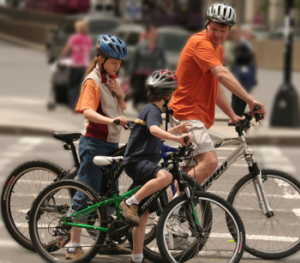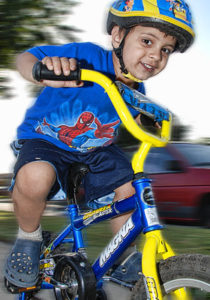By Dave Topham
The Bike-Walk Alliance of New Hampshire web site text, videos, and adult bike safety classes all echo the New Hampshire state and national laws concerning where bikes are legally allowed to be used by adults. Adult bicyclists, as “vehicle operators,” are expected to follow the rules of the road — and “vehicle operators” are not allowed to drive on sidewalks. Children under 16 years of age are not eligible to be legal “vehicle operators”. They don’t have a driver’s license and more importantly, they generally don’t have the skills, cognitive abilities, or strength to handle a bike on the road mixing with high-speed motor vehicle traffic, turn lanes, complex intersections, etc.
The NH Department of Transportation (NHDOT), the NH Department of Safety (NHDOS), the League of American Bicyclists (LAB), and National Highway Traffic Safety Administration (NHTSA) all acknowledge that children should be on sidewalks and travel at walking speed (3-4 MPH), especially for the 13-and-under age group. There are exceptions, like if a 12-year-old has matured to the level of being a skilled cyclist and can pedal safely on the road. The legality of riding on sidewalks for any age rider is usually determined at the local municipality level. Compact business districts typically ban all cycling on sidewalks, where in residential and light motor traffic areas, children are expected to be on the sidewalks. Note that if a child is riding with parents, the whole family is likely to be on the road, but the child is not making decisions about handing the bike around the motorists. This link to the NHTSA page is a good reference:
https://one.nhtsa.gov/people/injury/pedbimot/bike/kidsandbikesafetyweb/index.htm
 The concept of “situational awareness” also plays a role in determining if a bicyclist of any age uses the roadway or sidewalk. Consider, for example, locations where it may be challenging even for adult bicyclists to ride in the roadway, such as a multiple lane roadway, with no designated bike lane, a 4-way intersection, and heavy motor vehicle traffic doing 30-40 miles per hour or more. Throw in a hill too so now the bicyclist has to climb, which means their speed is even slower than normal. Let’s say this same roadway also includes a sidewalk with little or no pedestrian traffic and good sightlines. If a bicyclist needs to use this type of roadway to get to his\her destination, and needs to make a left hand turn through an intersection here, in a situation like this using the sidewalk is safest travel way. Keep in mind NH law does not include an exemption for this situation. If the bicyclist were to hit a pedestrian in this situation, this would be used against them. Bicyclists always need to yield to pedestrians, and travel at safe, reasonable speeds.
The concept of “situational awareness” also plays a role in determining if a bicyclist of any age uses the roadway or sidewalk. Consider, for example, locations where it may be challenging even for adult bicyclists to ride in the roadway, such as a multiple lane roadway, with no designated bike lane, a 4-way intersection, and heavy motor vehicle traffic doing 30-40 miles per hour or more. Throw in a hill too so now the bicyclist has to climb, which means their speed is even slower than normal. Let’s say this same roadway also includes a sidewalk with little or no pedestrian traffic and good sightlines. If a bicyclist needs to use this type of roadway to get to his\her destination, and needs to make a left hand turn through an intersection here, in a situation like this using the sidewalk is safest travel way. Keep in mind NH law does not include an exemption for this situation. If the bicyclist were to hit a pedestrian in this situation, this would be used against them. Bicyclists always need to yield to pedestrians, and travel at safe, reasonable speeds.
A little common sense can go a long way. Rules of the road for vehicle operators (motorists and bicyclists) should be followed for the safety of all, but young children are not “vehicle operators.” They are typically riding bikes for fun (recreationally), with no idea of the dangers that may be encountered when riding on roadways with motor vehicle traffic. As parents, adults, bike safety instructors, and safety officials, we need to keep children as safe as possible. That includes having them bike on sidewalks (where legal) until they are old enough to be responsible “vehicle operators.”
For example, the town of Durham, which includes the University of New Hampshire campus, does allow bicyclists to use some “shared pathways and sidewalks” with pedestrians within the campus grounds and even some areas of downtown Durham, which is still part of the UNH campus. These are typically wider sidewalks that are designed to accommodate both user types, and bicyclists are still always expected to yield to pedestrians and travel at reasonable (slow) speeds.



